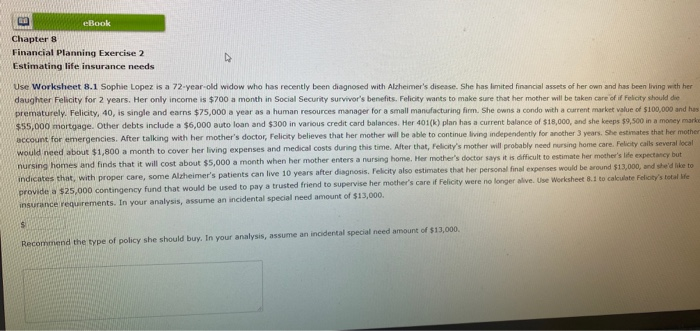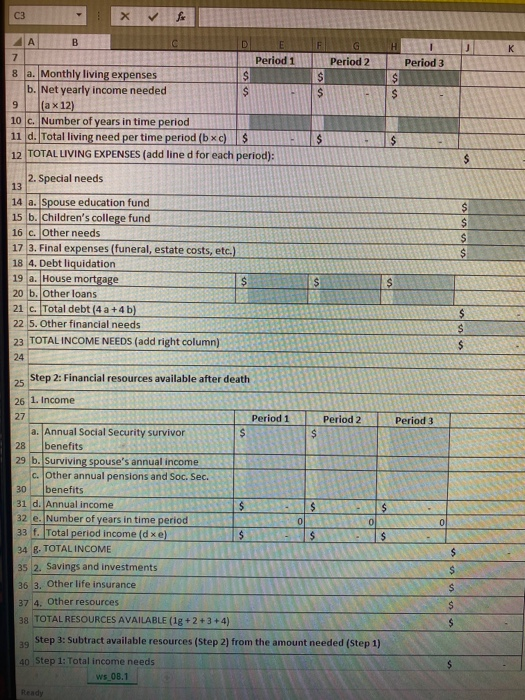eBook Chapter 8 Financial Planning Exercise 2 Estimating life insurance needs Use Worksheet 8.1 Sophie Lopez is a 72-year-old widow who has recently been diagnosed with Alzheimer's disease. She has limited financial assets of her own and has been living with her daughter Felicity for 2 years. Her only income is $700 a month in Social Security survivor's benefits. Felicity wants to make sure that her mother will be taken care of if Felicity should die prematurely. Felicity, 40, is single and earns $75,000 a year as a human resources manager for a small manufacturing firm. She owns a condo with a current market value of $100,000 and has $55,000 mortgage. Other debts include a $6,000 auto loan and $300 in various credit card balances. Her 401(k) plan has a current balance of $18,000, and she keeps $9,500 in a money marke account for emergencies. After talking with her mother's doctor, Felicity believes that her mother will be able to continue living independently for another 3 years. She estimates that her mother would need about $1,800 a month to cover her living expenses and medical costs during this time. After that, Felicity's mother will probably need nursing home care. Felicity calls several local nursing homes and finds that it will cost about $5,000 a month when her mother enters a nursing home. Her mother's doctor says it is difficult to estimate her mother's life expectancy but indicates that, with proper care, some Alzheimer's patients can live 10 years after diagnosis. Felicity also estimates that her personal final expenses would be around $13,000, and she'd like to provide a $25,000 contingency fund that would be used to pay a trusted friend to supervise her mother's care if Felicity were no longer slive. Use Worksheet 8.1 to calculate Felicity's totale insurance requirements. In your analysis, assume an incidental special need amount of $13,000 S Recommend the type of policy she should buy. In your analysis, assume an incidental special need amount of $13,000. for C3 X B K G Period 2 Period 3 $ $ $ $ $ $ D 7 Period 1 8 a. Monthly living expenses $ b. Net yearly income needed $ 9 (a x 12) 10 C. Number of years in time period 11 d. Total living need per time period (bxc) $ 12 TOTAL LIVING EXPENSES (add line d for each period): 2. Special needs 13 14 a. Spouse education fund 15 b. Children's college fund 16 c. Other needs 17 3. Final expenses (funeral, estate costs, etc.) 18 4. Debt liquidation 19 a. House mortgage $ 20 b. other loans 21 c. Total debt (4 a +4 b) 22 5. Other financial needs 23 TOTAL INCOME NEEDS (add right column) 24 $ $ $ $ $ $ $ $ $ Period 3 0 25 Step 2: Financial resources available after death 26 1. Income 27 Period 1 Period 2 a. Annual Social Security survivor $ $ 28 benefits 29 b. Surviving spouse's annual income c. Other annual pensions and Soc. Sec. 30 benefits 31 d. Annual income $ $ $ 32 e. Number of years in time period 0 0 33 f. Total period income (dxe) $ $ $ 34 8. TOTAL INCOME 35 2. Savings and investments 36 3. Other life insurance 37 4. Other resources 38 TOTAL RESOURCES AVAILABLE (18 +2+3+4) 39 Step 3: Subtract available resources (Step 2) from the amount needed (Step 1) 40 Step 1: Total income needs ws 08.1 Ready $ $ $ $ $ $ 39 Step 3! Sube avail $ 40 Step 1: Total income needs 41 Step 2: Available resources 42 ADDITIONAL LIFE INSURANCE NEEDED 43 44 AS eBook Chapter 8 Financial Planning Exercise 2 Estimating life insurance needs Use Worksheet 8.1 Sophie Lopez is a 72-year-old widow who has recently been diagnosed with Alzheimer's disease. She has limited financial assets of her own and has been living with her daughter Felicity for 2 years. Her only income is $700 a month in Social Security survivor's benefits. Felicity wants to make sure that her mother will be taken care of if Felicity should die prematurely. Felicity, 40, is single and earns $75,000 a year as a human resources manager for a small manufacturing firm. She owns a condo with a current market value of $100,000 and has $55,000 mortgage. Other debts include a $6,000 auto loan and $300 in various credit card balances. Her 401(k) plan has a current balance of $18,000, and she keeps $9,500 in a money marke account for emergencies. After talking with her mother's doctor, Felicity believes that her mother will be able to continue living independently for another 3 years. She estimates that her mother would need about $1,800 a month to cover her living expenses and medical costs during this time. After that, Felicity's mother will probably need nursing home care. Felicity calls several local nursing homes and finds that it will cost about $5,000 a month when her mother enters a nursing home. Her mother's doctor says it is difficult to estimate her mother's life expectancy but indicates that, with proper care, some Alzheimer's patients can live 10 years after diagnosis. Felicity also estimates that her personal final expenses would be around $13,000, and she'd like to provide a $25,000 contingency fund that would be used to pay a trusted friend to supervise her mother's care if Felicity were no longer slive. Use Worksheet 8.1 to calculate Felicity's totale insurance requirements. In your analysis, assume an incidental special need amount of $13,000 S Recommend the type of policy she should buy. In your analysis, assume an incidental special need amount of $13,000. for C3 X B K G Period 2 Period 3 $ $ $ $ $ $ D 7 Period 1 8 a. Monthly living expenses $ b. Net yearly income needed $ 9 (a x 12) 10 C. Number of years in time period 11 d. Total living need per time period (bxc) $ 12 TOTAL LIVING EXPENSES (add line d for each period): 2. Special needs 13 14 a. Spouse education fund 15 b. Children's college fund 16 c. Other needs 17 3. Final expenses (funeral, estate costs, etc.) 18 4. Debt liquidation 19 a. House mortgage $ 20 b. other loans 21 c. Total debt (4 a +4 b) 22 5. Other financial needs 23 TOTAL INCOME NEEDS (add right column) 24 $ $ $ $ $ $ $ $ $ Period 3 0 25 Step 2: Financial resources available after death 26 1. Income 27 Period 1 Period 2 a. Annual Social Security survivor $ $ 28 benefits 29 b. Surviving spouse's annual income c. Other annual pensions and Soc. Sec. 30 benefits 31 d. Annual income $ $ $ 32 e. Number of years in time period 0 0 33 f. Total period income (dxe) $ $ $ 34 8. TOTAL INCOME 35 2. Savings and investments 36 3. Other life insurance 37 4. Other resources 38 TOTAL RESOURCES AVAILABLE (18 +2+3+4) 39 Step 3: Subtract available resources (Step 2) from the amount needed (Step 1) 40 Step 1: Total income needs ws 08.1 Ready $ $ $ $ $ $ 39 Step 3! Sube avail $ 40 Step 1: Total income needs 41 Step 2: Available resources 42 ADDITIONAL LIFE INSURANCE NEEDED 43 44 AS









